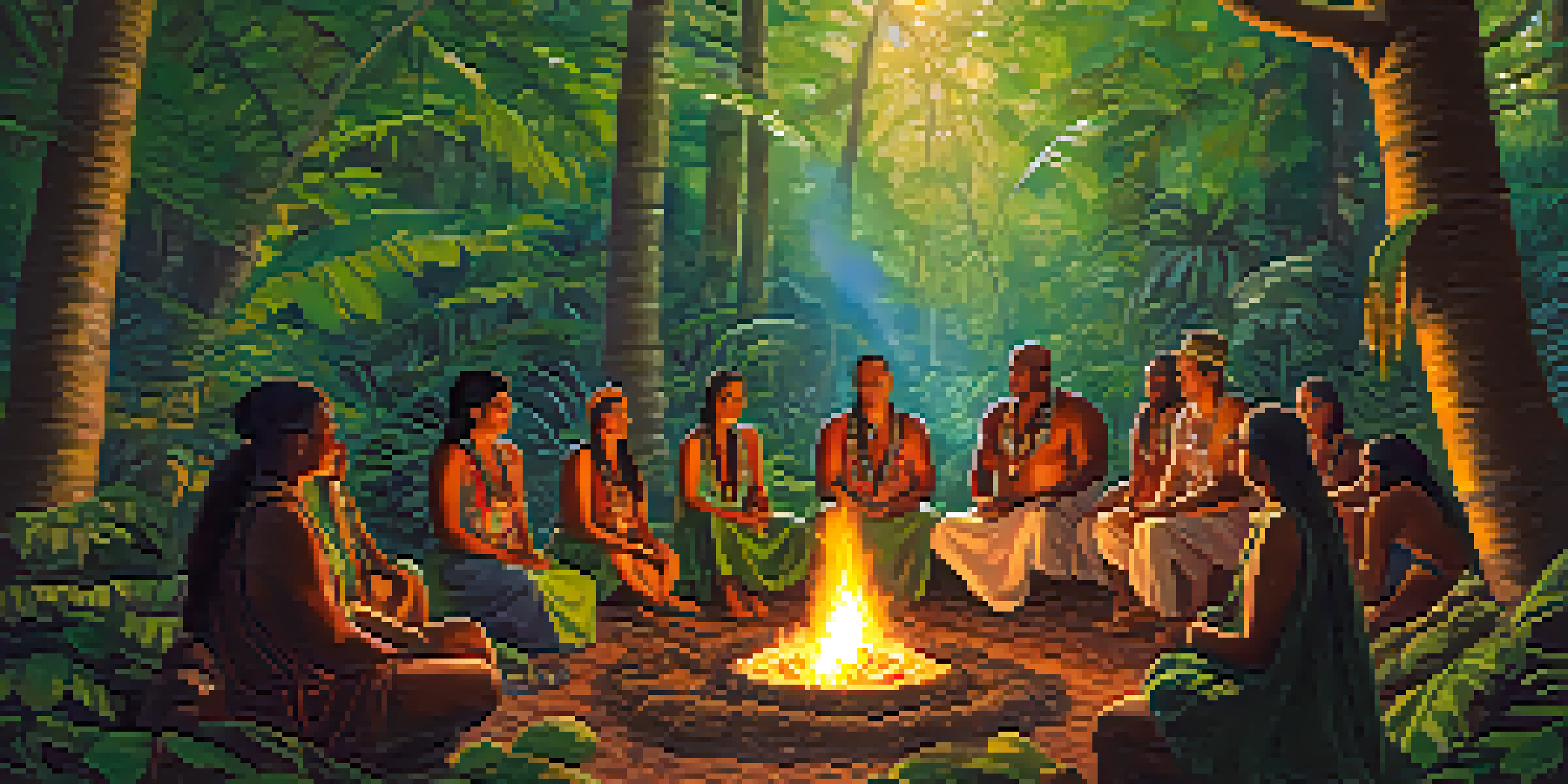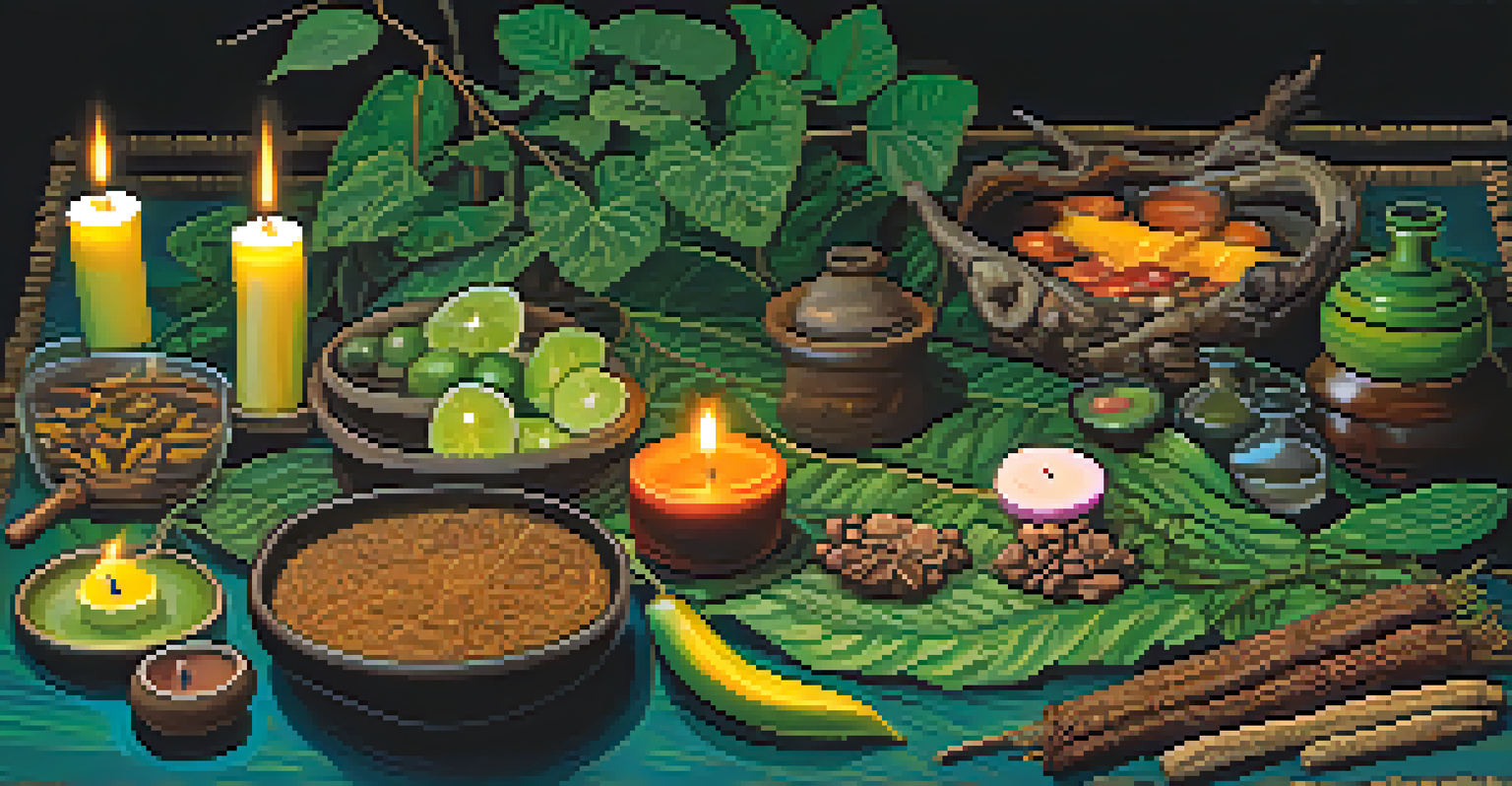Intergenerational Perspectives on Ayahuasca in Indigenous Cultures

Understanding Ayahuasca: A Cultural and Spiritual Journey
Ayahuasca is more than just a plant; it's a gateway to understanding the interconnectedness of life. For many indigenous cultures, this powerful brew serves as a vehicle for spiritual insight and healing. The experience of consuming ayahuasca often leads to profound revelations, allowing individuals to connect with their ancestors and nature.
The plant is a teacher, and it teaches you about yourself and your place in the world.
The preparation and consumption of ayahuasca are steeped in cultural rituals, often led by a shaman who guides participants through their journey. These practices are passed down through generations, embodying the values, beliefs, and traditions of the community. As younger generations engage with this practice, they seek to balance traditional knowledge with modern perspectives.
This blend of old and new creates a rich tapestry of experiences where both elders and youth contribute their views. For many, ayahuasca becomes a shared family experience, fostering deeper connections across generations as they navigate its complexities together.
Intergenerational Transmission of Knowledge and Practices
In indigenous cultures, knowledge about ayahuasca and its uses is often transmitted from elders to younger members. This passing of wisdom is crucial, as it ensures the survival of cultural practices and beliefs. Elders play a pivotal role in teaching the significance of ayahuasca, highlighting its importance in healing and community bonding.

However, as globalization influences indigenous communities, younger generations may feel torn between traditional teachings and contemporary lifestyles. They often seek to adapt these practices to resonate with their own experiences, leading to a unique blend of perspectives. This adaptation can sometimes create tension but also opens up new avenues for understanding and exploration.
Cultural Significance of Ayahuasca
Ayahuasca serves as a vital tool for spiritual insight and healing, connecting participants to their cultural roots and community.
Ultimately, this intergenerational dialogue fosters a deeper appreciation for the complexities of ayahuasca. It encourages respect for ancestral wisdom while allowing for innovation, ensuring that the practice remains relevant in a rapidly changing world.
The Role of Elders in Ayahuasca Ceremonies
Elders hold a revered position in indigenous cultures, especially during ayahuasca ceremonies. They serve as guides, helping participants navigate their experiences and interpret the teachings that arise. Their vast knowledge and spiritual authority are essential in creating a safe space for introspection and healing.
Indigenous knowledge is not just about the past; it is about the future and how we can adapt to our changing world.
Through storytelling and sharing personal experiences, elders enrich the ceremony, offering context that younger participants might lack. These narratives often include lessons learned from past missteps and triumphs, reinforcing the importance of community and interconnectedness. Such sharing not only honors tradition but also inspires youth to engage meaningfully with their heritage.
In this way, elders act as bridges between the past and the present, ensuring that the sacredness of ayahuasca remains intact. Their influence shapes how younger generations approach these ceremonies, emphasizing respect, intention, and mindfulness.
Youth Perspectives: Navigating Tradition and Modernity
For many young people in indigenous cultures, ayahuasca represents a duality of tradition and modernity. While they recognize its cultural significance, they also grapple with contemporary influences that challenge traditional practices. This can lead to a quest for personal meaning, as youth seek to carve out their own relationship with ayahuasca.
Some young individuals embrace ayahuasca as a tool for personal growth, often participating in ceremonies to explore their identities and navigate modern life challenges. They bring fresh ideas and interpretations, sometimes blending traditional elements with new-age practices. This innovation can enrich the experience, allowing for a more personalized approach to healing.
Intergenerational Knowledge Sharing
Elders play a crucial role in passing down the significance and practices of ayahuasca, fostering respect and understanding among younger generations.
However, the desire to innovate can sometimes clash with traditional beliefs, leading to discussions about authenticity and cultural preservation. Finding common ground between respect for tradition and the need for personal expression is a central theme in the evolving narrative around ayahuasca.
The Impact of Globalization on Ayahuasca Practices
Globalization has dramatically influenced the perception and use of ayahuasca beyond indigenous communities. As interest in plant medicine grows worldwide, many individuals are drawn to ayahuasca for its purported therapeutic benefits. This influx raises questions about cultural appropriation and the commodification of sacred practices.
For indigenous peoples, the global fascination with ayahuasca can be both a blessing and a challenge. While it brings attention to their traditions, it can also dilute the cultural significance and lead to misinterpretations of its practices. Maintaining the integrity of ayahuasca ceremonies in the face of commercial interests becomes a priority for many communities.
As younger generations witness this shift, they often advocate for responsible practices that honor their heritage. By promoting education and awareness, they aim to protect their cultural identity while engaging with a broader audience interested in the healing properties of ayahuasca.
Ayahuasca as a Tool for Healing and Community Cohesion
In many indigenous cultures, ayahuasca is viewed as a powerful tool for healing, not only at the individual level but also for the community. The shared experience of ceremony can strengthen bonds among participants, fostering a sense of belonging and collective healing. This communal aspect is particularly important in times of social upheaval or personal crisis.
Elders often emphasize the importance of community support during and after ceremonies, encouraging participants to share their experiences openly. This dialogue can lead to communal healing and a deeper understanding of shared struggles. In this way, ayahuasca serves as a catalyst for creating stronger, more resilient communities.
Globalization's Impact on Practices
As ayahuasca gains global interest, indigenous communities face challenges in preserving their traditions while navigating cultural appropriation.
As younger generations embrace this communal healing aspect, they often seek to integrate ayahuasca into broader community practices. This creates opportunities for intergenerational collaboration, where both youth and elders work together to nurture their cultural identity while addressing contemporary issues.
Future Directions: Sustaining Ayahuasca Traditions
Looking ahead, the future of ayahuasca practices in indigenous cultures hinges on balancing tradition with modern influences. As younger generations continue to engage with ayahuasca, it's crucial to find ways to preserve the cultural integrity of these ceremonies while allowing for personal interpretation. This balance can create a vibrant, evolving practice that honors the past while embracing the future.
Education plays a vital role in this process, with both elders and youth committed to sharing knowledge about the significance of ayahuasca. By fostering an environment of mutual respect and understanding, communities can ensure that the teachings surrounding ayahuasca remain alive and relevant. This collaborative approach empowers youth to carry forward their cultural heritage with pride.

Ultimately, the journey of ayahuasca in indigenous cultures reflects broader themes of resilience, adaptation, and connection. As these communities navigate the complexities of modern life, their relationship with ayahuasca will likely evolve, continuing to inspire and heal for generations to come.